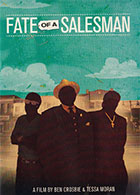
Fate of a Salesman 2013
Distributed by Icarus Films, 32 Court St., 21st Floor, Brooklyn, NY 11201; 800-876-1710
Produced by Ben Crosbie and Tessa Moran
Directed by Ben Crosbie and Tessa Moran
DVD, color, 27 min.
General Adult
African American Culture, Business, Fashion Design, Urban Areas
Date Entered: 08/19/2015
Reviewed by Timothy Hackman, University of Maryland“I don't say he's a great man. Willie Loman never made a lot of money. His name was never in the paper. He's not the finest character that ever lived. But he's a human being, and a terrible thing is happening to him. So attention must be paid. He's not to be allowed to fall in his grave like an old dog. Attention, attention must finally be paid to such a person.” – Arthur Miller, Death of a Salesman
Fate of a Salesman chronicles the last year of the Men’s Fashion Center, a fixture on H Street in Northeast Washington, DC since 1952. The cast of characters is small, and the connections between them are deep: owner Jerry Goldkind, whose father Murray, a Jewish immigrant from Poland, started the store the same year Jerry was born; salesman Willie Carswell, who started washing windows for Jerry’s father, took over as store manager upon the senior Goldkind’s death, and who has worked a total of forty five years at the store; salesman Steve Davidson, a regular customer who ended up homeless and considering suicide before Willie offered him a job and a second chance; and a handful of customers who stop in to shop for new suits, ties, shoes, and hats for church, or sometimes just to shoot the breeze. The film’s style is observational; there is no voiceover narration, no expository charts or graphs, no advanced lectures on American economics, real estate, or urban development. We simply see Willie and Steve hemming and pressing pants, ordering inventory by phone (“I need ties like I need air to breathe,” Willie tells one supplier), fitting and upselling customers, strategizing for sales, while the business they love slips slowly away.
The film backtracks via archival photos to the 1950s on H Street, at the time a thriving lower-middle income African American neighborhood. The 1968 riots decimated the neighborhood, as they did parts of Baltimore, Chicago, and other cities, but Men’s Fashion Center’s side of the street was miraculously spared. The store hung on through the 1970s to the glory days of the 1980s and early 1990s, leading up to consecutive years of almost one million dollars in sales in 1994 and 1995. (“We made so. Much. Money,” recalls Willie happily.)
By 2011, however, when Fate of a Salesman was filmed, the store was struggling badly. Part of the blame fell on the economic downturn, but the deeper issue was the changing demographics of H Street itself. While Men’s Fashion Center built its business on a middle class, African American customer base – “the gentleman going to church” as Willie describes the typical customer – the neighborhood was (and is) gentrifying, steadily becoming richer and whiter. In an especially emblematic sequence of shots, Willie and Steve look on in bemusement as a crowd, mostly white, enjoys punk music and food trucks at the 2011 H Street NE Festival, where a tent for “upscale urban apartments” beckons potential renters to “Live Where It’s At” and a lone teenager breakdances on an otherwise empty stage, black street expression commodified.
When the store’s closing comes, it is not a surprise to the viewer or to the men who work there. Still, observes Steve, it “felt like a family member telling you really bad news.” One final party, one final sale, and the metal doors rolled down over the store windows for the last time in October 2012.
Brief and briskly paced at just 27 minutes, Fate of a Salesman offers an engaging look at a way of life, and of making a living. Although the focus is on a single store and three men, the same story is playing out daily in urban areas around the country. As such, the film is a useful resource for teachers, professors, and students in urban studies and African American studies, as well as for those who understand that “attention must finally be paid” to men like Willie.
Awards
- Audience Award, Best Short Documentary, 2014 Decade of Docs
- Audience Award, Best Short Documentary, 2014 Annapolis Film Festival
- Juror’s Choice Award, 2013 Black Maria Film Festival